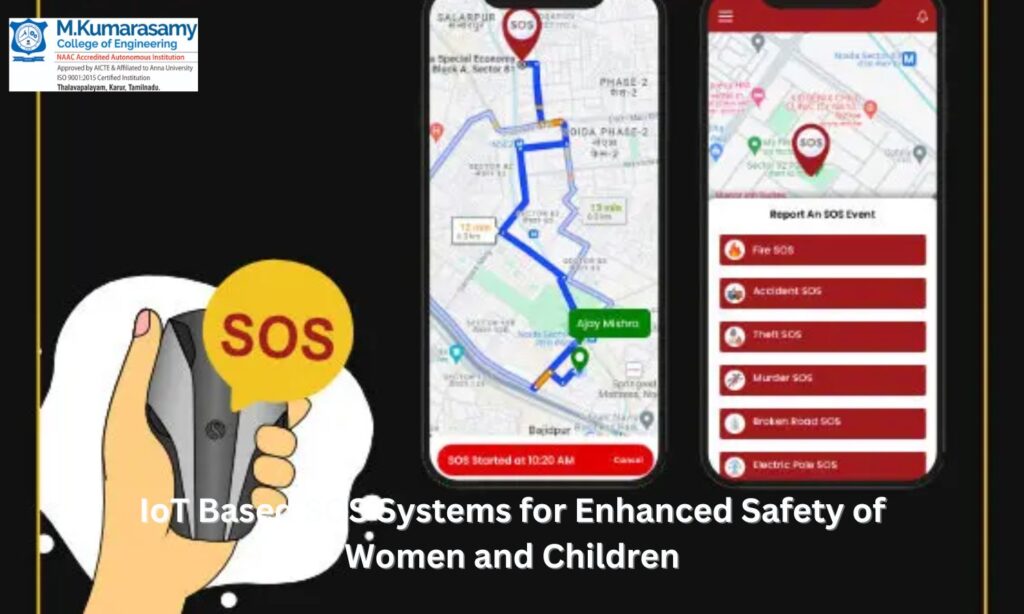Safety concerns for women and children have taken center stage in today’s society, demanding innovative solutions. IoT based SOS systems stand out as revolutionary tools designed to ensure the safety of vulnerable individuals. These systems leverage cutting-edge Internet of Things (IoT) technology to create robust, real-time, and effective responses to emergencies. At M.Kumarasamy College of Engineering (MKCE), this concept has been integrated into the curriculum, ensuring that students gain expertise in developing life-saving technologies.
What Are IoT Based SOS Systems?
IoT based SOS systems represent an amalgamation of IoT devices, mobile applications, and cloud computing. These systems aim to provide immediate assistance during emergencies by transmitting distress signals to authorities, family members, or caregivers. By utilizing GPS, wearable devices, and smart sensors, IoT based SOS systems ensure accurate location tracking and quick response times. Their capability to operate autonomously makes them indispensable in safeguarding women and children from potential harm.
Key Features of IoT Based SOS Systems
- Real-Time Monitoring: IoT devices constantly monitor the user’s environment, identifying potential threats. Advanced sensors detect unusual movements or sounds, automatically triggering alerts when necessary.
- Geo-Fencing: This feature establishes safe zones for individuals. If a user steps outside predefined areas, the system sends instant notifications to assigned contacts.
- Wearable Technology: From smartwatches to pendants, wearable devices form the backbone of IoT based SOS systems. These gadgets house GPS modules, panic buttons, and communication tools, ensuring seamless emergency assistance.
- Cloud Connectivity: IoT based SOS systems use cloud servers to store data and facilitate rapid information exchange. This ensures scalability and uninterrupted performance.
- Integration with Authorities: These systems can alert law enforcement or emergency services directly, significantly reducing response times and mitigating risks.
Applications of IoT Based SOS Systems

The applications of IoT based SOS systems extend far beyond theoretical frameworks. They are actively transforming the safety landscape, particularly for women and children. For instance, schools and educational institutions have adopted these systems to ensure the security of students. Similarly, working women rely on IoT-based personal safety devices during commutes or late-night shifts. Even in domestic settings, these systems protect children from intruders or other dangers, giving parents peace of mind.
The Role of MKCE in Advancing IoT Based SOS Systems
At M. Kumarasamy College of Engineering, departments such as Electronics and Communication Engineering (ECE) and Computer Science Engineering (CSE) emphasize IoT technologies. By teaching the principles of IoT based SOS systems, MKCE equips students with the skills to design and deploy advanced safety solutions. Collaborative projects, industry partnerships, and hands-on training ensure that students not only grasp theoretical concepts but also excel in practical implementation.
MKCE’s commitment to fostering innovation has enabled its students to create prototypes that address real-world safety challenges. These efforts align with global trends, where IoT solutions are increasingly employed to combat gender-based violence and ensure child protection.
Benefits of IoT Based SOS Systems
IoT based SOS systems offer numerous advantages over traditional safety measures. They provide instantaneous alerts, ensuring timely intervention. Unlike conventional systems that rely on manual operation, these IoT solutions function autonomously, reducing human error. Their ability to integrate with smartphones and home automation systems makes them versatile and user-friendly. Furthermore, these systems operate round-the-clock, offering unwavering vigilance.
Another significant benefit is data-driven insights. IoT based SOS systems collect and analyze data to identify patterns, helping authorities and policymakers take preventive measures. For example, areas with frequent distress signals can be flagged as high-risk zones, prompting immediate attention.
Challenges and the Way Forward
Despite their immense potential, IoT based SOS systems face several challenges. Privacy concerns arise due to continuous monitoring and data sharing. Developers must ensure robust encryption and data protection measures to gain user trust. Additionally, the cost of implementation can be prohibitive, particularly in underprivileged regions. Addressing these issues requires collaboration between governments, tech companies, and academic institutions like MKCE.
To overcome these challenges, innovation must focus on creating cost-effective and scalable solutions. Open-source platforms and community-driven development can significantly reduce expenses. Furthermore, spreading awareness about the importance of IoT based SOS systems will encourage wider adoption.
Future Trends in IoT Based SOS Systems
The evolution of IoT based SOS systems continues to reshape safety protocols. The integration of Artificial Intelligence (AI) promises smarter systems capable of predictive analytics. For instance, AI-enabled SOS devices can assess risk levels based on user behavior, environment, and past incidents, preemptively activating safety measures.
Another promising trend is 5G connectivity, which enhances the speed and reliability of IoT communications. This ensures that distress signals reach recipients in real-time, regardless of location. Moreover, advancements in battery technology will make wearable devices more efficient, extending their operational lifespan.
Conclusion
IoT based SOS systems stand at the forefront of safety innovation, offering a lifeline to women and children in perilous situations. These systems exemplify the transformative power of IoT, showcasing its ability to address critical societal issues. At M.Kumarasamy College of Engineering, the integration of this concept into academic programs ensures that future engineers are well-equipped to enhance these systems further. By harnessing the potential of IoT, we can create a safer world for everyone, one device at a time.
